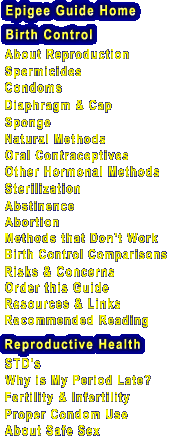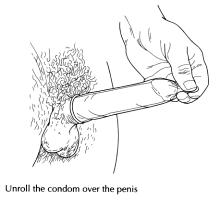








Instructions For Using Condoms
When used consistently and correctly, latex or polyurethane condoms can help prevent reproductive tract infections, including infection with the human immunodeficiency virus (HIV). Condoms also provide good protection against unintended pregnancy. Bear in mind, however, that condoms can fail or break, even when used properly. Abstinence is the best way to avoid STD and accidental pregnancy.
BEFORE INTERCOURSE
- Have on hand an adequate supply of:
- latex or polyurethane condoms, even if you plan to use another contraceptive
- water-based lubricant (see table)
- extra condoms available in case the first is damaged or torn before use, put on incorrectly, or if you have repeated intercourse
- Discuss condom use before you have intercourse.
| Condom Comparisons | |||
|---|---|---|---|
| Type | Latex | Plastic | Natural Skin |
| Protects against: | pregnancy & STD | pregnancy & STD | pregnancy only |
| Material: | natural rubber | polyurethane | lamb membrane |
| Cost: | low | moderate/high | moderate |
| Some brand names: |
° LifeStyles Extra Sensitive ° Beyond Seven |
° Durex Avanti ° Trojan Supra |
° Trojan Naturalamb ° Fourex |
| Source: R. Hatcher et al., "Contraceptive Technology," 17th ed., 1998, Table 16-1. | |||
AT TIME OF INTERCOURSE

- Open the condom package carefully to avoid damaging it with fingernails, teeth, or other sharp objects.
- Put on the condom before the penis comes in contact with the partner's mouth, anus, or vagina. If the penis is uncircumcised, pull the foreskin back before putting on the condom. Keep the condom on the penis until after intercourse or ejaculation.
- Unroll the condom a short distance to make sure the condom is being unrolled in the right direction. The rolled ring should be on the outside. Then hold the tip of the condom and unroll it down to the base of the erect penis. If the condom does not unroll easily, it is on upside-down and may expose the partner to infectious organisms contained in the pre-ejaculate. Discard and begin with a new condom.
- Adequate lubrication is important. For latex condoms, use only water-based lubricants like water; lubricating jellies (e.g., K-Y Jelly); or spermicidal creams, jellies, foam, or suppositories. Avoid oil-based lubricants like cold cream, mineral oil, cooking oil, petroleum jelly, body lotions, massage oil, or baby oil that can damage latex condoms (see table below). For polyurethane condoms, any type of lubricant can be used.
- If the condom breaks or falls off during intercourse but before ejaculation, stop and put on a new condom. A new condom can also be used when you have prolonged intercourse or different types of intercourse within a single session (e.g., vaginal and anal).
| Lubricants Which Can and Cannot be Used with Latex Condoms | |
|---|---|
| Safe | Unsafe |
|
|
| Source: R. Hatcher et al., "Contraceptive Technology," 17th ed., 1998, Table 16-7. | |
AFTER INTERCOURSE
- Soon after ejaculation, withdraw the penis while it is still erect. Hold the condom firmly against the base of the penis to prevent slippage and leakage of semen.
- Check the condom for visible damage such as holes, then wrap it in tissue and discard. Do not flush condoms down the toilet.
- If the condom breaks, falls off, leaks, or is not used--
- Gently wash the penis, vulva, anus, and adjacent areas with sopa and waater immediately after intercourse to help reduce the risk of acquiring an STD. Then insert an applicator full of spermicide into the vagina as soon as possible.
- Discuss the possibility of pregnancy or infection with your partner and contact your health care provider as soon as you can. Do not douche.
- Use a new condom from "start to finish" with each act of vaginal, oral, or anal intercourse. Do not reuse condoms.

TAKING CARE OF SUPPLIES
- Store condoms in a cool and dry place out of direct sunlight (heat may weaken latex).
- Check the expiration or manufacture date on the box or individual package of condoms. Expiration dates are marked as "Exp"; otherwise, the date is the manufacture date (MFG). Latex condoms should not be used beyond their expiration date or more than 5 years after the manufacturing date. Latex condoms with spermicide should probably be used within 2 years of the manufacture date. Condoms in damaged packages or that show obvious signs of deterioration (e.g., brittleness, stickiness, or discoloration) should not be used regardless of their expiration date.
Source: R. Hatcher et al., "Contraceptive Technology," 17th ed., 1998, p.347-9.
- At this site:
- The following links are provided as an informational resource or counterpoint and are not necessarily endorsed by the author:
 : Buy Condoms On-Line through this US Condom Distributer
: Buy Condoms On-Line through this US Condom Distributer
- Spermicides & Lubricants
: from Drugstore.com
- Condoms UK: United Kingdom Condom Distributer
- Teens and Birth Control Failure Rates
- Consumer Reports: How Reliable Are Condoms?

Return to Condoms Page
Visitors Since 3-10-01.
Updated: March 17, 2003
